Nocardia farcinica
A Microbial Biorealm page on the genus Nocardia farcinica
Classification
Higher order taxa
Superkingdom: Bacteria
Phylum: Actinobacteria
Class: Actinobacteria
Subclass: Actinobacteridae
Order: Actinomycetales
Suborder: Corynebacterineae
Family: Nocardiaceae
Genus: Nocardia
(1,2)
Species
Nocardia farcinica
(1,2)
Description and significance
Species of the Nocardia Genus are Gram positive bacteria. Their cell envelope consists of a peptidoglycan cell wall, inside of which lay the cell membrane; a lipid bilayer with imbedded proteins. They are saprophytic, their habitats vary based on their need to grow and live on dead and/or decaying organic material. Soils, plants, animal tissues, and human tissues make ideal environments for growth. (3)
Farcinica are rod or coccoid shaped, filamentous, produce endospores, are non motile, are obligate aerobes, and experience optimal growth at body temperature. (3,4) Nocardia colonies vary from white, to tan, orange and red in color. An image of Nocardia farcinica is not available for publication on MicrobeWiki at the date of this entry, but the following are provided for comparison:
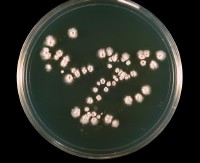
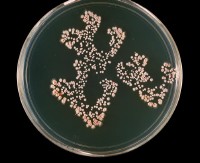
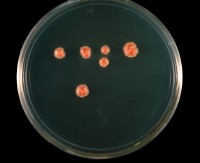
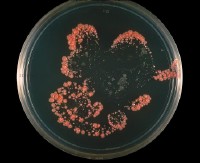
All four images above show Nocardia asteroides grown on the same media, at the same temperature. Variances in size, color, and shape of colonies are apparent.
Images provided by CDC/Dr. William Kaplan
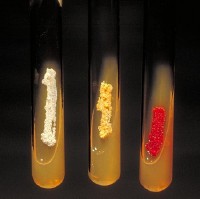
Left tube: Actinomadura madurae, Middle tube: Nocardia asteroides, Right tube: Micromonspora.
Image provided by CDC/Dr. David Berd
Nocardia farcinica images that are not available for publication on this site show colonies that are golden, to light, medium, and dark orange. The colonies appear globular and shiny with surfaces ranging from smooth to reticulated. (5,6)
The genus Nocardia was first discovered Edmund Nocard, a French veterinarian, in 1889 as the cause of bovine infections. Nocardia farcinica is significant to modern medicine as it is a pathogen which threatens both human health and the health of important assets such as herds of cattle, horses, and many other animals. It is particularly resistant to treatment, and a high mortality rate among those infected. (7)
Genome structure
Describe the size and content of the genome. How many chromosomes? Circular or linear? Other interesting features? What is known about its sequence? Does it have any plasmids? Are they important to the organism's lifestyle?
Cell structure and metabolism
Describe any interesting features and/or cell structures; how it gains energy; what important molecules it produces.
Ecology
Describe any interactions with other organisms (included eukaryotes), contributions to the environment, effect on environment, etc.
Pathology
How does this organism cause disease? Human, animal, plant hosts? Virulence factors, as well as patient symptoms.
Application to Biotechnology
Does this organism produce any useful compounds or enzymes? What are they and how are they used?
Current Research
Enter summaries of the most recent research here--at least three required
References
Edited by Julie Crownover, student of Rachel Larsen and Kit Pogliano
